
India, US Eye Mutually Beneficial Trade Pact


India and the US are currently engaged in talks to establish a "mutually advantageous, well-balanced bilateral trade agreement" (BTA), and these trade discussions are "making good progress," according to Union Commerce Minister Piyush Goyal.
Addressing inquiries about the potential threat of retaliatory tariffs impacting various countries, including India, from the Trump administration starting April 2, Goyal stated, "Trade negotiations for a bilateral trade agreement are proceeding. This is a matter of public knowledge since we witnessed the joint press conference between President Trump and Prime Minister Modi, where both leaders announced the commencement of negotiations aimed at concluding by (the) Fall, 2025." The minister spoke at the Times Now Summit 2025 in New Delhi.
He noted that discussions are underway. "They’re progressing positively, and will benefit both the United States and India," he emphasized. Goyal mentioned that he maintains "regular and ongoing" communications with industry representatives from every sector and various organizations related to agriculture, exports, engineering, electronics, and textiles. Numerous interest groups are in continuous dialogue with the government, and "everyone is very enthusiastic about a potential bilateral trade agreement" with the US.
When asked about the government’s plan to keep India at the forefront of the global order and transition it into a developed nation by 2047, Goyal stated that the aim is to increase India’s GDP by approximately eight times by 2047.
"We are currently around $4 trillion, and we expect that by 2047 India will reach a $30-35 trillion economy."
He indicated that this target is attainable through the "three key pillars" outlined by PM Modi over the past 11 years. The first is to enhance India's macro-economic situation. "Every fundamental aspect of the economy has been fortified in the last 11 years," he remarked.
The second pillar focuses on promoting inclusive and sustainable growth to ensure that even those at the lowest economic levels experience a better quality of life, which is being realized through inclusive development.
The third pillar emphasizes continued investment and consumption-driven growth, which has propelled India from being one of the fragile five a decade ago to the fifth largest economy in the world, he noted.
Expanding on the third point, he explained that it is based on two components — public welfare, which has significantly boosted consumer demand and thus consumption, and the emphasis on infrastructure investments, which drives investment-led growth.
Also Read: Nitin Gadkari: Becoming the Highwayman of India
His comments regarding the developed world alluded to India’s engagement with the European Union and the UK to establish individual free trade agreements (FTAs).